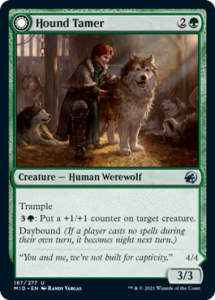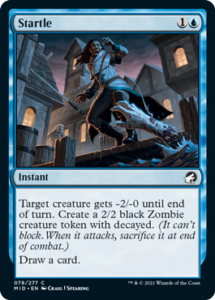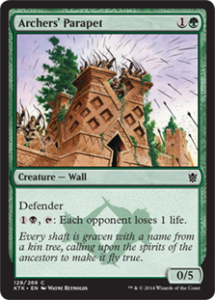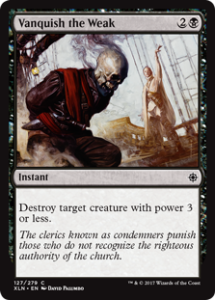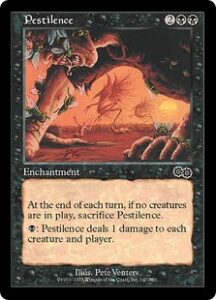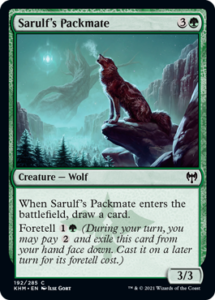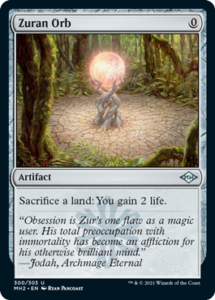The Features of a Great Limited Format

I haven’t played constructed much recently. I’m enjoying a long break after years of grinding endless Standard for League Weekends. Also, while I think Midnight Hunt is a solid-to-great Limited format, the color imbalance within the set has caused me to become bored of it. This got me thinking about what I value in a Limited format, so here’s my criteria for what makes for a great Limited format.
Balanced Colors/Archetypes
One lesson we’re currently living through with Innistrad: Midnight Hunt Limited is that unbalanced colors can limit the replayability of a format. I like Midnight Hunt Limited, but it doesn’t get that extra boost because blue and black are so much better than the next thing. Sets like Battle for Zendikar, Guilds of Ravnica, and straight Amonkhet were examples of unbalanced colors that made the formats get stale quickly. This isn’t to say that colors need to be completely balanced as there will always be a best and worst color, but the margin between the best and second should be thin in a perfect Limited format.

Mana Flood and Mana Screw Protection
It’s easier to account for access to mana than it is to protect players who miss land drops. For Mana flood it’s adding mechanics for spending extra mana for additional effects. Flashback, Kicker, Cycling, expensive activated abilities, and activated abilities that net you extra cards are easy ways to account for mana flood protection.
Mana screw is more of a nuisance and generally occurs when you’re missing a color. One thing that prevents that is a common cycle of dual lands such as Guildgates. There are also times you’re missing your third land drop and cheap but effective cantrips or cycling cards can help you stay afloat in these games. A good example from our current set is a card like Startle. Startle allows you to cycle, gain a little life if timely, and leave a weak onboard resource to use for later.
Lastly, cheap removal can make it so formats don’t turn into snowballs rolling down a hill, even if the power level of the creatures is high. If you’re missing land drops but still able to effectively interact with the three- and four-mana creatures your opponent is playing, you can potentially turn the game around. This also goes for cheap effective blockers that don’t turn into dead cards throughout the game. An example is a card like Archers’ Parapet from Khans of Tarkir.
Efficient Removal/Interaction
My favorite Limited formats are back-and-forth resource management games when both players are able to make choices and the choices matter. Efficient removal is important. The formats where the best removal is five mana and sorcery speed tend to be more aggressive and test you for having a strong opening hand. It’s not my favorite when this happens, but a format like this is Ixalan. Contract Killing was a premium black removal spell, as Vanquish the Weak had its own limitations. The format played out fast with a low curve, so games were more about goldfishing than interaction. This changed with the inclusion of Rival of Ixalan, but this format is still on my bad side because of how little I interacted with my opponent and how much more frequently I was trying to stay part of my tribe and do whatever tribal thing I could do faster than my opponent.

Strong Common/High Power Level
Urza’s Block limited is one of my favorite Limited formats of all time because some of the best cards in the format are common! Pestilence was a very strong common, one of the best of all time, but it was beatable. This format also did not have as many strong rares as we see these days, so it made for a more balanced experience. There were still strong cards, many of which would pass even today’s Standard for power level. This is something we’re seeing more and more of these days with cards like Organ Hoarder and Sarulf’s Packmate as great rate commons. It’s always nice to be excited to open a specific common when you miss out on a good rare or uncommon, right? The master’s sets do scaled-up power levels best, and if I finished my tier list, I’d likely have a high density of masters sets at the top because of how well curated they are to hit this note, amongst all of the others on my list.
Unique Mechanics
While there are some mechanics, like maybe Cycling or Kicker or Flashback that would be nice to have in any format, having new, interesting, and unique mechanics is a huge plus for the longevity of a Limited format. It gets even better when the threshold for making these mechanics work is harder to meet. Threshold from Odyssey block is a unique mechanic that made games very interesting. Managing resources, like graveyard size while balancing if a land was more valuable in your hand, graveyard or on the battlefield, made for fun games. I’m not a huge fan of that format for other reasons, but it did make accomplishing the goal of hitting Thresholds a fun thing to work toward both while drafting and playing.

Fun Payoffs/Enablers
The payoffs for the mechanics or synergies in the set have to be rewarding. This is very important to the player experience. A mechanic that executed this poorly was Guilds of Ravnica. Undergrowth was hard to achieve traditionally, and the payoff was too low within the contexts of the format to make it worthwhile. There were a few incredible cards with the mechanics but little self-mill, the Guild was fairly weak because its main mechanic was not worthwhile. This created a big guild imbalance, and when there are only five guilds and two of them are clearly worse than the other three, it didn’t take long to get bored playing against Dimir Control. Adding a couple of extra enablers like a Grisly Salvage-type card at common rarity would have helped make drafting Golgari fun rather than “I had to go Golgari because it was the only thing open.”
Cross-Synergies
Something I think is getting better over time is how synergies and mechanics in sets intertwine well together. Stuff like BW Sacrifice and UB Zombies cross-synergize so well, as does GB and UG Self-Mill. Having your archetypes intertwine so well is important because it makes the gameplay experience and drafting more desirable. Picking a premium blue common like Organ Hoarder is enabling my self-mill and Zombies decks and works well with Disturb. This focus has gotten much better in recent years, and I’m excited to see how they continue to make this work as new mechanics present themselves.
Hidden or Rare Archetypes/Combos
The epitome of what I’m talking about with regards to a hidden archetype is a deck like UG Self-Mill Spider Spawning from Innistrad, but also in sets where you can narrowly piece together something like a coin-flip deck in Modern Horizons II. Sometimes you get three or four cards spread out across all rarities for an archetype that isn’t a heavily supported archetype. A recent example was when I was finally able to put together the combo of Zuran Orb and Titania, Protector of Argoth. Having these goals to work toward is always a way to keep a format fresh and have more unique experiences with the format.

Nostalgia
People tend to hold the first Limited sets they fall in love with in high regard. It’s impossible to shake that feeling so any set I’m nostalgic about is always going to rate higher for me even if objectively the set is worse. For example, I love Mercadian Masques Limited, which is a pretty unpopular opinion. We always look fondly on the past.
These are my criteria for what makes for great Limited Magic. Some of my favorite sets are the original Vintage Masters, Modern Horizons II, original Innistrad, Eternal Masters, and Modern Masters II. The sets that I least enjoy are Onslaught Block, Kamigawa Block, and Adventures of the Forgotten Realms. Both Amonkhet and Ixalan were saved by their follow-up set. Amonkhet has the biggest delta between one of my least favorite formats and most favorite with the inclusion of Hour of Devastation.
What are your favorite Limited formats, and what about them do you gravitate to?
Image Copyright: (c) 1995-2020 Wizards of the Coast LLC, All Rights Reserved





